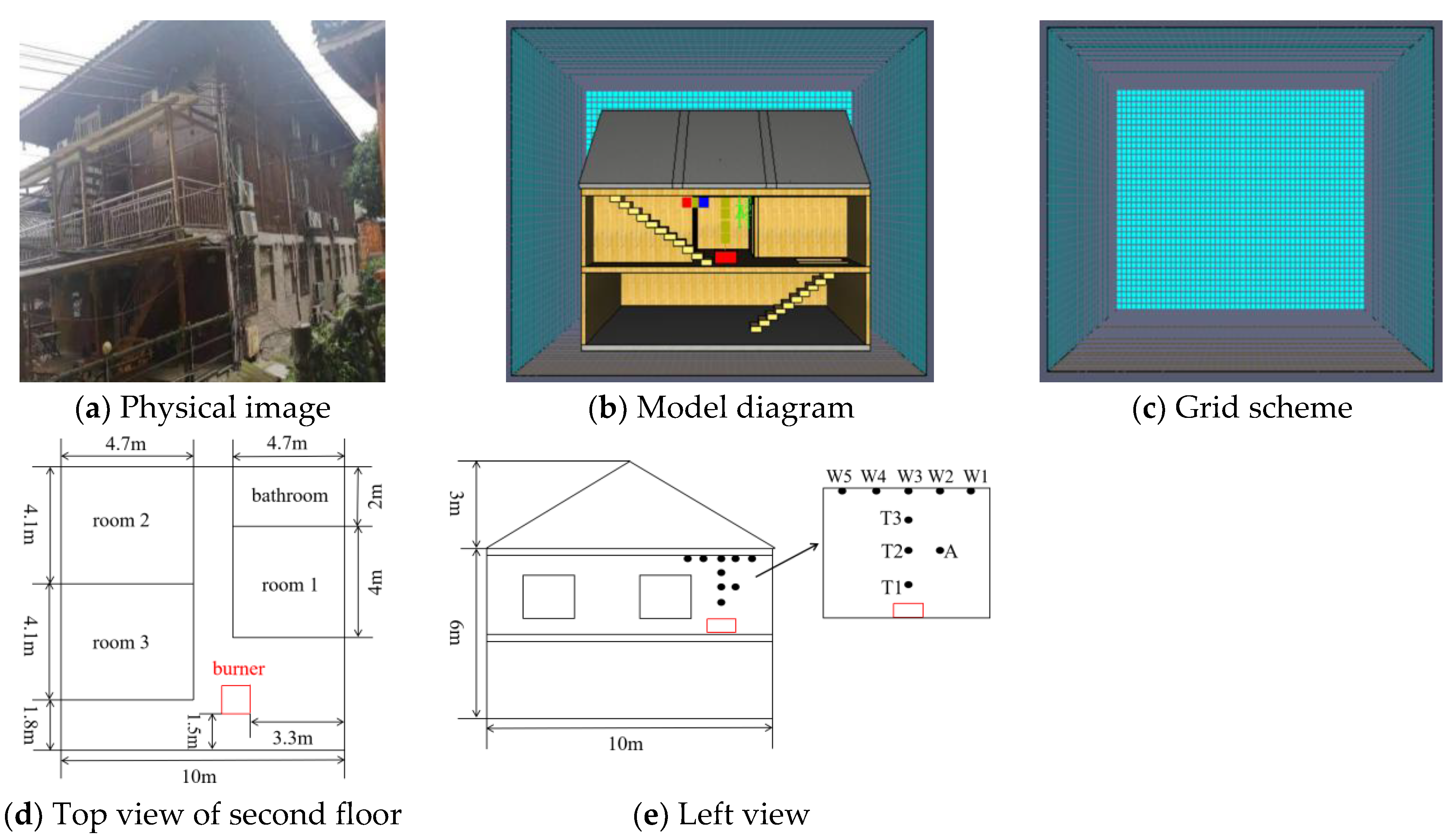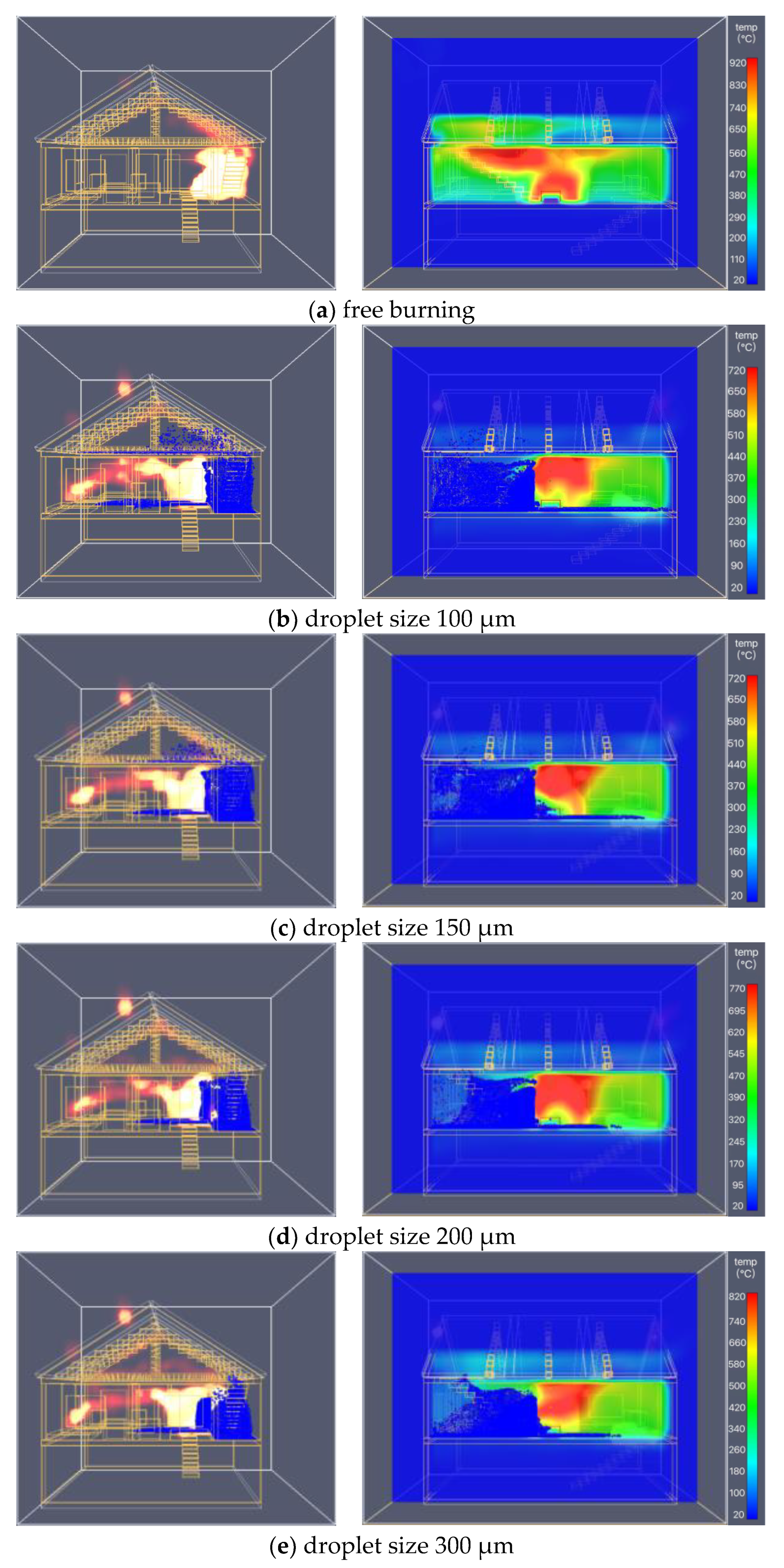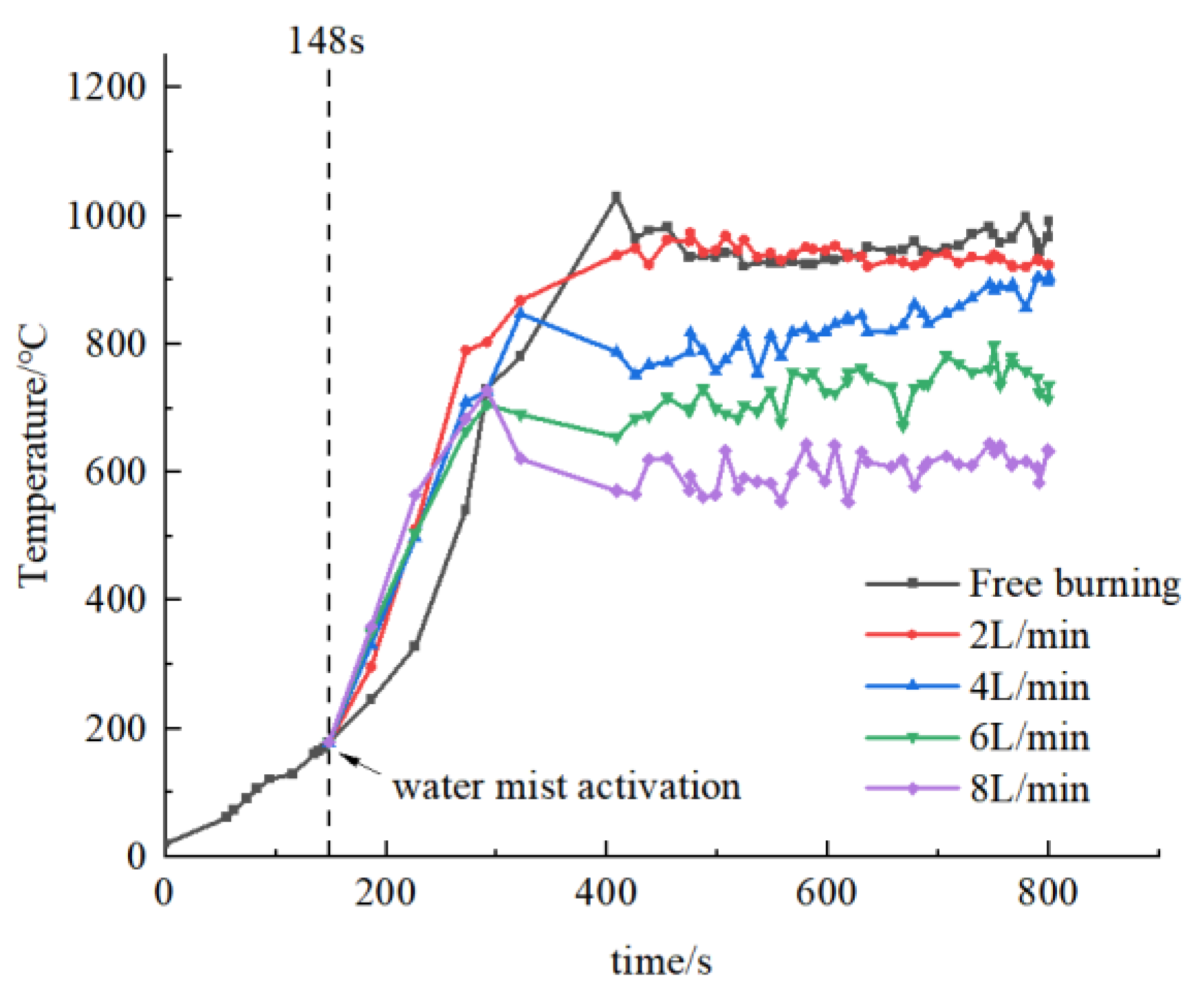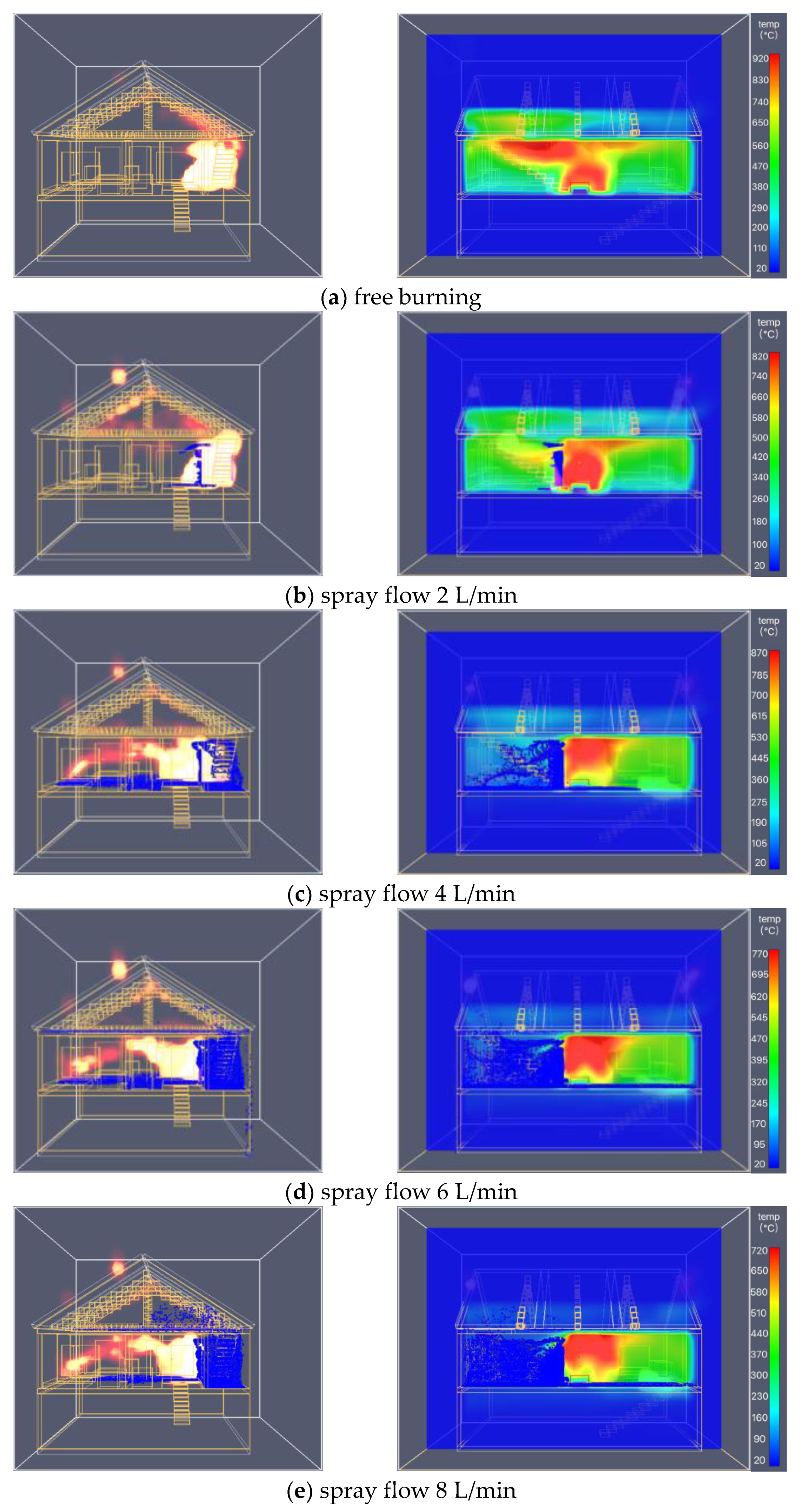Numerical Simulation of Fire Suppression in Stilted Wooden Buildings with Fine Water Mist Based on FDS
Abstract
:1. Introduction
2. Fire Modeling and Setting of Related Parameters
2.1. Stilted Building Model
2.2. Governing Equation
2.3. Parameter Setting and Meshing
3. Simulation Results and Analysis
3.1. Influence of Droplet Size on the Fire-Extinguishing Effect
3.2. Influence of Different Spray Flow Rates on the Fire-Extinguishing Effect
3.3. Influence of Different Nozzle Densities on Fire-Extinguishing Effect
4. Conclusions
- (1)
- The fine-water-mist fire-extinguishing system exhibits heat-absorbing and cooling effects on fires in stilted buildings with wooden structures, and they can inhibit the further development of fires and play a positive role in fire emergency rescue.
- (2)
- When the flow rate of the fine water mist and the density of the nozzle remain unchanged, the fine water mist with a small droplet diameter exhibits a good evaporative heat absorption effect. The smaller the particle size, the faster the vaporization rate and the better the cooling effect. The cooling effect of droplets with a size of 150 μm or less is better than that of droplets with sizes of 200 μm and 300 μm.
- (3)
- When the particle size and nozzle density of the fine water fog remain unchanged, the temperature of the fire field decreases faster with the flow rate, and the cooling efficiency is the highest when the flow rate is 8 L/min. If conditions permit, the maximum spray flow can be selected within the specified range to achieve the best fire-extinguishing effect.
- (4)
- When the droplet size and the flow rate of the fine water mist remain unchanged, the fire-extinguishing effect at the fire site is not obvious when setting up a water-mist nozzle. When the density of the water nozzles is increased, the water mist between the nozzles overlaps, making the porosity of the water mist smaller and preventing the spread of the fire.
Author Contributions
Funding
Data Availability Statement
Conflicts of Interest
References
- Ministry of Emergency Management. Ministry of Emergency Management of the People’s Republic of China. Regular Press Conference in January 2022 [EB/OL]. 2022. Available online: https://www.mem.gov.cn/xw/xwfbh/2022n1y20rxwfbh/ (accessed on 20 January 2022).
- Guillaume, E.; Dréan, V.; Girardin, B.; Fateh, T. Reconstruction of the grenfell tower fire–part 4: Contribution to the understanding of fire propagation and behaviour during horizontal fire spread. Fire Mater. 2020, 44, 1072–1098. [Google Scholar] [CrossRef]
- Oh, T.H.; Park, C.S. Improvement of Performance based wooden building National Fire Safety Codes. J. Korea Saf. Manag. Sci. 2016, 18, 83–92. [Google Scholar]
- Oh-Sang, K. The Study on Compartment Fire Experiment According to Fire Load. Fire Sci. Eng. 2017, 31, 16–22. [Google Scholar]
- Ekr, J.; Caldova, E.; Vymlatil, P.; Wald, F.; Kuklikova, A. Timber steel-fibre-reinforced concrete floor slabs subjected to fire. Eur. J. Wood Prod. 2018, 76, 201–212. [Google Scholar] [CrossRef]
- Chen, L.Z.; Xu, Q.F.; Leng, Y.B.; Harries, K.A.; Wang, Z.L. Experimental study of performance of engineered bamboo beams exposed to three-sided standard fire. Fire Saf. J. 2019, 106, 52–60. [Google Scholar] [CrossRef]
- Menis, A.; Fragiacomo, M.; Clemente, I. Fire resistance of unprotected cross-laminated timber floor panels: Parametric study and simplified design. Fire Saf. J. 2019, 107, 104–113. [Google Scholar] [CrossRef]
- Wei, S.; Yang, H.; Gao, B.; Cheng, H.; Lu, R.; Dong, L. Experimental research on temperature distribution and charring rate of typical components of wood structure building. J. Fire Sci. 2022, 40, 134–152. [Google Scholar] [CrossRef]
- Gao, B.; Wei, S.; Du, W.; Yang, H.; Chu, Y. Experimental Study on the Fire Resistance Performance of Partition Board under the Condition of Small Fire Source. Processes 2021, 9, 1818. [Google Scholar] [CrossRef]
- Wang, Y.N.; Qiu, H. Numerical analysis of spreading law of ancient timber building group fire based on FDS. China Saf. Sci. J. 2014, 24, 26–32. [Google Scholar]
- SUN, G.L. Analysis of ancient buildings fire spreading based on PyroSim. Fire Sci. Technol. 2016, 35, 214–218. [Google Scholar]
- Yi, X.L.; Zheng, L.P. Performance-based fire protection assessment ancestral temple in canton based on fire dynamics simulator. Build. Sci. 2021, 37, 89–97+103. [Google Scholar]
- GUO, F.L.; Chen, P.; Wang, X.Y.; Jin, K. On Characteristics of Fire spreading Among Stilt-styled House Complex with Timber Structure. Cite Towns Constr. Guangxi 2012, 10, 85–90. [Google Scholar]
- Betting, B.; Varea, E.; Gobin, C.; Godard, G.; Lecordier, B.; Patte-Rouland, B. Experimental and numerical studies of smoke dynamics in a compartment fire. Fire Saf. J. 2019, 108, 102855. [Google Scholar] [CrossRef]
- Ding, H.C.; Xu, Y.D.; Deng, Q.L.; Lian, Z. Simulation study on influence of fire smoke flow on evacuation in high-rise buildings. China Saf. Sci. J. 2020, 30, 118–124. [Google Scholar]
- Colin, C.; Jason, J.; Jason, P. Sensitivity of atypical lateral fire spread to wind and slope. Geophys. Res. Lett. 2016, 43, 1744–1751. [Google Scholar]
- Weng, W.G.; Kamikawa, D.; Fulcuda, Y. Study on flame height of merged flame from multiple fire sources. Combust. Sci. Technol. 2004, 76, 2105–2123. [Google Scholar] [CrossRef]
- Wu, S.F.; Yuan, Y.P. Simulation Research on Suppression and Extinguishment of Fires in a Ship Engine Room by Water Mist based on FDS. Shipbuild. China 2020, 61, 170–187. [Google Scholar]
- Wang, Z.H. Application of high-pressure water mist fire extinguishing system in Shanghai Tower. Water Wastewater 2015, 05, 80–81. [Google Scholar]
- Xiong, W.R. Discussion on the application of water mist fire extinguishing system in cultural relics and ancient buildings. China New Commun. 2017, 19, 90–91. [Google Scholar]
- Xu, W. Study on the Mechanism of Inhibition of Hydrocarbon Flame by Some Halon Substitutes. Ph.D. Thesis, University of Science and Technology of China, Hefei, China, 2017. [Google Scholar]
- Chiu, C.W.; Li, Y.H. Full-scale experimental and numerical analysis of water mist system for sheltered fire sources in wind generator compartment. Process Saf. Environ. Prot. 2015, 98, 40–49. [Google Scholar] [CrossRef]
- Mahmud, H.M.I.; Moinuddin, K.A.M.; Thorpe, G.R. Experimental and numerical study of high-pressure water-mist nozzle sprays. Fire Saf. J. 2016, 81, 109–117. [Google Scholar] [CrossRef]
- Gupta, M.; Pasi, A.; Ray, A.; Kale, S.R. An experimental study of the effects of water mist characteristics on pool fire suppression. Exp. Therm. Fluid Sci. 2013, 44, 768–778. [Google Scholar] [CrossRef]
- Ye, Y.B.; Zhai, Y.Y.; Ma, L.J.; Zhang, Y.P.; Ke, H.Y. Numerical simulation method for controlling fire spread in stilted building of Dong nationality. Fire Sci. Technol. 2019, 38, 814–817. [Google Scholar]
- Cheng, M.; Li, Y.; Ren, Y.X. Analysis on the effect of fine water mist curtain blocking fire smoke spreading in subway tunnel. Fire Sci. Technol. 2019, 38, 519–521. [Google Scholar]
- LI, T.; Su, Z.M.; Chen, L.F.; Hu, A.-L.; Zhang, J. Cooling effeciency of high pressure water mist on fire urban underground pipe gallery. Fire Sci. Technol. 2019, 38, 966–969. [Google Scholar]
- Lee, E.; Choi, Y. Effects of particle size of dry water on fire extinguishing performance. J. Korean Soc. Saf. 2019, 34, 28–35. [Google Scholar]
- Ingason, H.; Li, Y.Z. Large scale tunnel fire tests with different types of large droplet fixed fire fighting systems. Fire Saf. J. 2019, 107, 29–43. [Google Scholar] [CrossRef]
- Liu, H.; Wang, C.; Cordeiro, I.M.D.C.; Yuen, A.C.Y.; Chen, Q.; Chan, Q.N.; Kook, S.; Yeoh, G.H. Critical assessment on operating water droplet sizes for fire sprinkler and water mist systems. J. Build. Eng. 2020, 28, 100999. [Google Scholar] [CrossRef]
- Ferng, Y.M.; Liu, C.H. Numerically investigating fire suppression mechanisms for the water mist with various droplet sizes through FDS code. Nucl. Eng. Des. 2011, 241, 3142–3148. [Google Scholar] [CrossRef]
- Yu, P.W.; Yang, W.Q.; Wu, J.K.; Zhang, F. Discussion on the application of high pressure water mist fire extinguishing system in the fire protection design of ancient buildings. Water Wastewater Eng. 2021, 47, 89–92+101. [Google Scholar]
- Yu, P.W.; Wang, Y.X.; Guo, Q.B.; Yang, W.; Qiao, Y.; Shi, X. Research on water damage of ancient wooden structure after spraying with high pressure water mist fire extinguishing system. Fire Sci. Technol. 2021, 40, 668–671+691. [Google Scholar]
- Li, Z.N.; Su, H.; Xiang, T.Y. Study on effect of ignition sources on flashover of ancient timber structure. Fire Sci. Technol. 2017, 36, 594–599. [Google Scholar]
- McGrattan, K.B.; Baum, H.R.; Rehm, R.G.; Hamins, A.; Forney, G.P.; Floyd, J.E.; Hostikka, S.; Prasad, K. Fire Dynamics Simulator--Technical Reference Guide; National Institute of Standards and Technology, Building and Fire Research Laboratory: Gaithersburg, MD, USA, 2000. [Google Scholar]
- Ko, Y.; Kinateder, M.; Elsagan, N. Water Mist Systems in Protection of Mass Timber Buildings. In International Scientific Conference on Woods & Fire Safety; Springer: Cham, Switzerland, 2020; pp. 404–409. [Google Scholar]
- Yuan, C.Y.; Fang, G.Z.; Zheng, G.K.; Li, Y. Temperature field analysis of ancient timber frame structure in the fire. Fire Sci. Technol. 2019, 38, 345–348. [Google Scholar]
- Lin, C.S.; Wang, S.C.; Hung, C.B.; Hsu, J.H. Ventilation effect on fire smoke transport in a townhouse building. Heat Transf.—Asian Res. Co-Spons. Soc. Chem. Eng. Jpn. Heat Transf. Div. ASME 2006, 35, 387–401. [Google Scholar] [CrossRef]
- Yuan, C.Y.; Zheng, G.K.; Lan, Y.J.; Wang, P.F. Study on fire characteristics of ancient buildings with brick-wood structure under different fire scenes. J. Saf. Sci. Technol. 2019, 15, 158–164. [Google Scholar]
- Jones, W.W.; Peacock, R.D.; Forney, G.P.; Reneke, P.A. CFAST–Consolidated Model of Fire Growth and Smoke Transport (Version 6); NIST Special Publication: Gaithersburg, MD, USA, 2005; p. 1026. [Google Scholar]
- Harmathy, T.Z.; Mehaffey, J.R. Design of Buildings for Prescribed Levels of Structural Fire Safety; ASTM International: West Conshohocken, PA, USA, 1985. [Google Scholar]
- Downie, B.; Polymeropoulos, C.; Gogos, G. Interaction of a water mist with a buoyant methane diffusion flame. Fire Saf. J. 1995, 24, 359–381. [Google Scholar] [CrossRef]
- McCaffrey, B.J. Jet diffusion flame suppression using water sprays—An interim report. Combust. Sci. Technol. 1984, 40, 107–136. [Google Scholar] [CrossRef]







| Growth Type | Fire Growth Factor kW/s2 | Typical Combustible Materials |
|---|---|---|
| Super-fast | 0.18780 | Oil pool fire, flammable home decorations, light curtains |
| Fast | 0.04689 | Bags stuffed full of stuff, plastic foam |
| Medium-fast | 0.01127 | Cotton and polyester items, wooden offices |
| Slow | 0.00293 | Heavy wood products |
| Typical Fire Sites | Maximum Heat Release Rate/MW |
|---|---|
| Malls with sprays | 5.0 |
| Spray offices and guest rooms | 1.5 |
| Public areas with sprays | 2.5 |
| Supermarkets and warehouses with sprays | 4.0 |
| Spray-free offices and guest rooms | 6.0 |
| Public places without spraying | 8.0 |
| Spray-free supermarkets and warehouses | 20.0 |
| Parameter | Setup |
|---|---|
| Spray speed | 5 m/s |
| Work pressure | 10 MPa |
| Spray angle | 60° |
| Initial nozzle temperature | 20.0 °C |
| Nozzle activation temperature | 74.0 °C |
| Droplets per second | 5000 |
| Working Conditions | Water-Mist Flow (L/min) | Number of Water-Mist Sprinklers | Water-Mist Droplet Size (μm) | 200 s | 400 s | 600 s | 800 s |
|---|---|---|---|---|---|---|---|
| free burning | 0 | 0 | 0 | 251 | 989 | 929 | 992 |
| different droplet sizes | 8 | 5 | 100 | 395 | 501 | 592 | 634 |
| 8 | 5 | 150 | 381 | 580 | 657 | 662 | |
| 8 | 5 | 200 | 264 | 670 | 724 | 777 | |
| 8 | 5 | 300 | 446 | 795 | 770 | 799 |
| Working Conditions | Water-Mist Flow (L/min) | Number of Water-Mist Sprinklers | Water-Mist Droplet Size (μm) | 200 s | 400 s | 600 s | 800 s |
|---|---|---|---|---|---|---|---|
| free burning | 0 | 0 | 0 | 251 | 989 | 943 | 992 |
| different spray flows | 2 | 5 | 100 | 377 | 933 | 929 | 924 |
| 4 | 5 | 100 | 409 | 759 | 824 | 905 | |
| 6 | 5 | 100 | 407 | 572 | 702 | 736 | |
| 8 | 5 | 100 | 395 | 501 | 592 | 634 |
| Working Conditions | Water-Mist Flow (L/min) | Number of Water-Mist Sprinklers | Water-Mist Droplet Size (μm) | 200 s | 400 s | 600 s | 800 s |
|---|---|---|---|---|---|---|---|
| free burning | 0 | 0 | 0 | 251 | 989 | 929 | 992 |
| different numbers of nozzles | 8 | 1 | 100 | 385 | 961 | 914 | 950 |
| 8 | 3 | 100 | 407 | 654 | 770 | 799 | |
| 8 | 5 | 100 | 395 | 501 | 592 | 634 |
Disclaimer/Publisher’s Note: The statements, opinions and data contained in all publications are solely those of the individual author(s) and contributor(s) and not of MDPI and/or the editor(s). MDPI and/or the editor(s) disclaim responsibility for any injury to people or property resulting from any ideas, methods, instructions or products referred to in the content. |
© 2023 by the authors. Licensee MDPI, Basel, Switzerland. This article is an open access article distributed under the terms and conditions of the Creative Commons Attribution (CC BY) license (https://creativecommons.org/licenses/by/4.0/).
Share and Cite
Zhao, X.; Wei, S.; Chu, Y.; Wang, N. Numerical Simulation of Fire Suppression in Stilted Wooden Buildings with Fine Water Mist Based on FDS. Buildings 2023, 13, 207. https://doi.org/10.3390/buildings13010207
Zhao X, Wei S, Chu Y, Wang N. Numerical Simulation of Fire Suppression in Stilted Wooden Buildings with Fine Water Mist Based on FDS. Buildings. 2023; 13(1):207. https://doi.org/10.3390/buildings13010207
Chicago/Turabian StyleZhao, Xinli, Shanyang Wei, Yunyun Chu, and Na Wang. 2023. "Numerical Simulation of Fire Suppression in Stilted Wooden Buildings with Fine Water Mist Based on FDS" Buildings 13, no. 1: 207. https://doi.org/10.3390/buildings13010207
APA StyleZhao, X., Wei, S., Chu, Y., & Wang, N. (2023). Numerical Simulation of Fire Suppression in Stilted Wooden Buildings with Fine Water Mist Based on FDS. Buildings, 13(1), 207. https://doi.org/10.3390/buildings13010207








